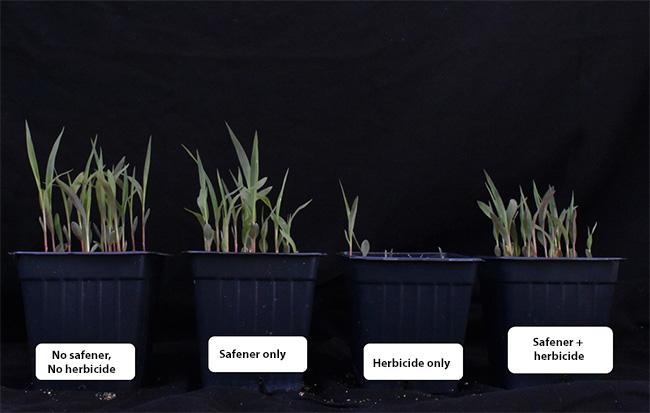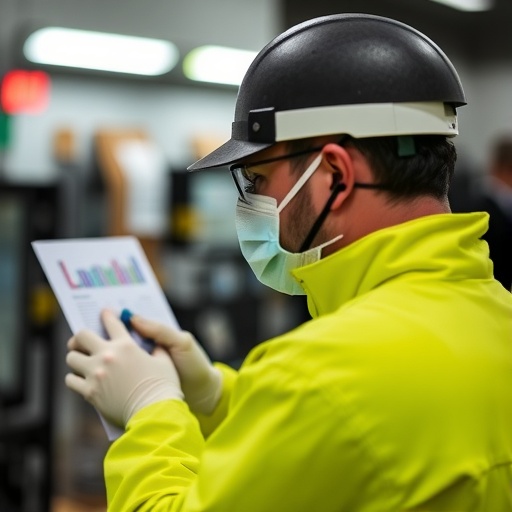
Credit: You Soon Baek, University of Illinois
URBANA, Ill. – Weeds often emerge at the same time as vulnerable crop seedlings and sneak between plants as crops grow. How do farmers kill them without harming the crops themselves?
Seed and chemical companies have developed two major technologies to avoid crop injury from soil- and foliar-applied herbicides: genetically modified herbicide-tolerant crops; and safeners, chemicals that selectively – and mysteriously – protect certain crops from damage. In a new University of Illinois study, researchers identify genes and metabolic pathways responsible for safener efficacy in grain sorghum.
The discovery goes a long way in explaining how safeners work. According to Dean Riechers, weed scientist in the Department of Crop Sciences at U of I and co-author on the Frontiers in Plant Science study, scientists serendipitously discovered safeners in the late 1940’s. Greenhouse-grown tomato plants were inadvertently exposed to a synthetic plant hormone during an experiment. The tomatoes showed no symptoms of exposure to the hormone itself, but when a herbicide was sprayed later, they were unharmed. Without fully understanding how they worked, researchers began experimenting to find more “herbicide antidotes” before commercializing the first safener (dichlormid) for corn in 1971.
Today, after nearly 50 years of commercial use in corn, rice, wheat, and grain sorghum, safeners remain a mystery. The existence of synthetic chemicals that selectively protect high-value cereal crops and not broadleaf crops or weeds is fascinating but doesn’t make intuitive sense, according to Riechers. Figuring out how the protective mechanism switches on in cereal crops could one day help scientists induce protection in broadleaf crops, like soybeans and cotton.
“Finding a safener that works in dicot crops would be the Holy Grail,” Riechers says.
The first step, however, is understanding what happens inside cells of cereal crops when exposed to safeners. In previous trials with grain sorghum, the research team noticed a massive increase in production of glutathione S-transferases (GSTs). These important enzymes, present in all living organisms, quickly detoxify herbicides and other foreign chemicals before they can cause damage. But that didn’t narrow the haystack very much.
“These cereal crops have up to 100 GSTs, and we didn’t know if one or more was providing the protective effect,” Riechers says. “We also couldn’t tell why GSTs were increased.”
The team used an approach known as a genome-wide association study. They grew 761 grain sorghum inbred lines in a greenhouse and compared plants treated with safener only, herbicide only, or both safener and herbicide. Scouring the genome for differences, they found specific genes and gene regions that were switched on in the safener-treated plants. Not surprisingly, they were genes that coded for two GSTs.
“Although we suspected GSTs were involved, this technique seemingly pinpointed the gene responsible for safening sorghum, SbGSTF1, along with a second tandem GST gene,” Riechers says.
In addition to finding this key gene for detoxification, the researchers also analyzed the RNA molecules expressed in safener-treated plants and revealed a plant defense pathway pulling double duty.
According to Riechers and co-author Patrick Brown, sorghum is well-known for producing allelochemicals, or chemical defenses, against insects and pathogens. One of these, dhurrin, is a chemical with a cyanide group. When it is under attack, sorghum releases a “cyanide bomb,” killing the insect or pathogen. It turns out some genes involved in dhurrin synthesis and metabolism were triggered in response to safeners, too.
“This link to dhurrin was kind of a clue – maybe the safener is tapping into a chemical defense pathway the plant is already using to protect itself,” Riechers says. “This is a new concept no one has ever proposed before in sorghum. It’s giving us some insight why the safener might be eliciting this response in the plant.”
The ability to turn on defenses and protective pathways with safeners could have all sorts of applications, according to Riechers. “It doesn’t seem logical there would be a pathway that’s only specific for synthetic herbicides,” he says. “Maybe safeners could be deployed to protect crops against insect herbivores, chemical pollutants, or environmental stresses. The possibilities and applications are very promising.”
The researchers have plans and funding to expand the experiment to wheat, and ultimately hope to identify more precise safener-herbicide-crop combinations that could eventually translate to broadleaf crops.
###
The article, “Transcriptome profiling and genome-wide association studies reveal GSTs and other defense genes involved in multiple signaling pathways induced by herbicide safener in grain sorghum,” is published in Frontiers in Plant Science [DOI: 10.3389/fpls.2019.00192]. Authors include You Soon Baek, Loren Goodrich, Patrick Brown, Brandon James, Stephen Moose, Kris Lambert, and Dean Riechers. The research was supported by USDA’s Agriculture and Food Research Initiative (grant no: 2015-67013-22818).
Media Contact
Lauren Quinn
[email protected]
Original Source
https:/
Related Journal Article
http://dx.




